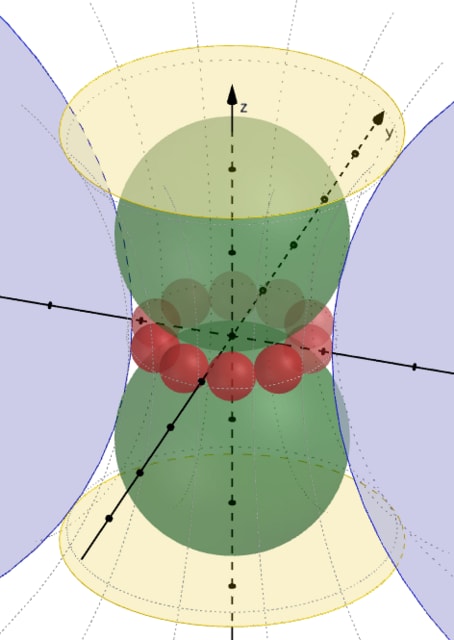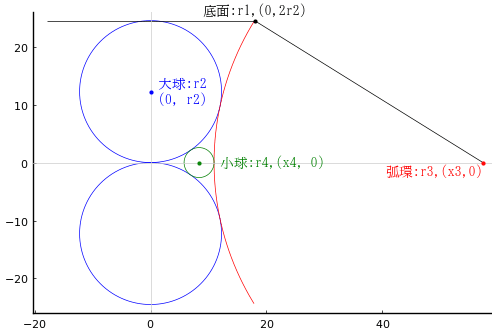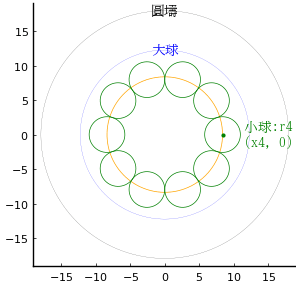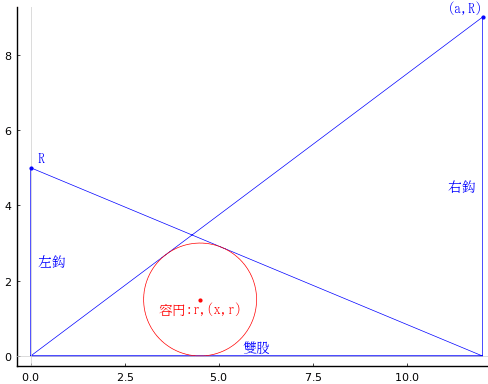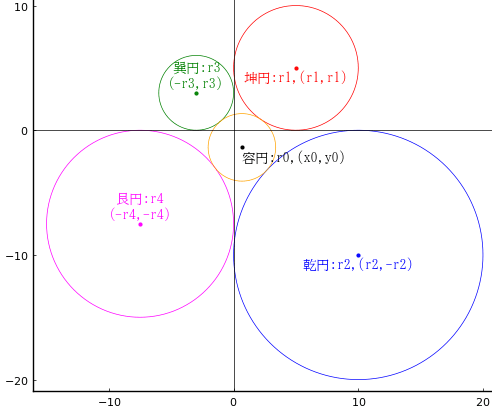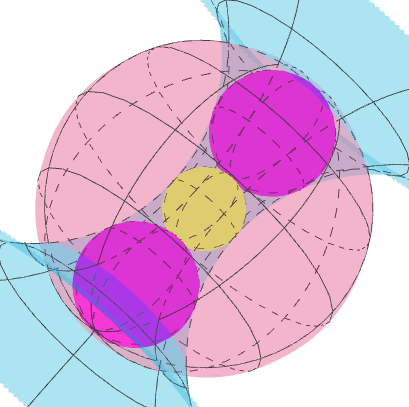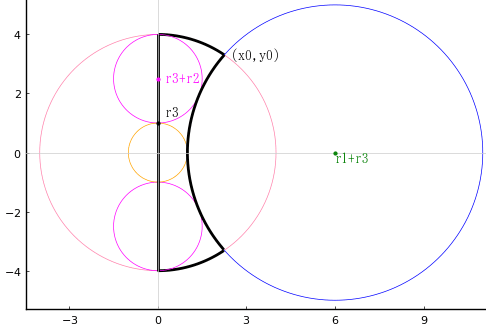算額(その802)
藤田貞資:精要算法(下巻),天明元年(1781)
http://www.wasan.jp/seiyou/seiyou.html
菱形の中に大円,中円,小円が入っている。小円と中円の直径の積が 1 寸(平方寸),双股(小円と中円が菱形と接する 2 点間の距離)が 5 寸のとき,大円の直径はいかほどか。

菱形の対角線を 2a, 2b
大円の半径と中心座標を r1, (0, 0)
中円の半径と中心座標を r2, (0, r1 + r2)
小円の半径と中心座標を r3, (r1 + r3, 0)
とおき,以下の連立方程式を解く。
include("julia-source.txt");
# julia-source.txt ソース https://blog.goo.ne.jp/r-de-r/e/ad3a427b84bb416c4f5b73089ae813cf
using SymPy
@syms a::positive, b::positive, r1::positive, r2::positive, r3::positive
c = sqrt(a^2 + b^2)
sinθ = b/c
cosθ = a/c
eq1 = 2r2*2r3 - 1
eq2 = c - (c - r1 - r2)*sinθ - (c -r1 - r3)*cosθ - 5//2
eq3 = r1 - a*sinθ
eq4 = r2 - (b - r1 - r2)*cosθ
eq5 = r3 - (a - r1 - r3)*sinθ;
using NLsolve
function nls(func, params...; ini = [0.0])
if typeof(ini) <: Number
r = nlsolve((vout, vin) -> vout[1] = func(vin[1], params..., [ini]), ftol=big"1e-40")
v = r.zero[1]
else
r = nlsolve((vout, vin)->vout .= func(vin, params...), ini, ftol=big"1e-40")
v = r.zero
end
return Float64.(v), r.f_converged
end;
function H(u)
(a, b, r1, r2, r3) = u
return [
4*r2*r3 - 1, # eq1
-a*(-r1 - r3 + sqrt(a^2 + b^2))/sqrt(a^2 + b^2) - b*(-r1 - r2 + sqrt(a^2 + b^2))/sqrt(a^2 + b^2) + sqrt(a^2 + b^2) - 2.5, # eq2
-a*b/sqrt(a^2 + b^2) + r1, # eq3
-a*(b - r1 - r2)/sqrt(a^2 + b^2) + r2, # eq4
-b*(a - r1 - r3)/sqrt(a^2 + b^2) + r3, # eq5
]
end;
iniv = BigFloat[4, 5, 0.3, 3, 0.74]
res = nls(H, ini=iniv)
([5.0, 3.75, 3.0, 0.3333333333333333, 0.75], true)
大円の直径は 6 寸である。
function draw(more)
pyplot(size=(500, 500), grid=false, aspectratio=1, label="", fontfamily="IPAMincho")
(a, b, r1, r2, r3) = res[1]
@printf("大円の直径 = %g\n", 2r1)
plot([a, 0, -a, 0, a], [0, b, 0, -b, 0], color=:magenta, lw=0.5)
circle(0, 0, r1)
circle(0, r1 + r2, r2, :blue)
circle(r1 + r3, 0, r3, :green)
if more == true
delta = (fontheight = (ylims()[2]- ylims()[1]) / 500 * 10 * 2) /3 # size[2] * fontsize * 2
hline!([0], color=:gray80, lw=0.5)
vline!([0], color=:gray80, lw=0.5)
end
end;























